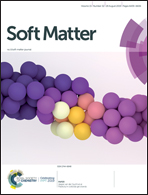Hydrogen bonded co-assembly of aromatic amino acids and bipyridines that serves as a sacrificial template in superstructure formation†
Abstract
Design and fabrication of superstructures are intriguing yet challenging tasks, which require delicate operations at micro/nanoscale such as template-directed seeding or etching processes. In this study, we prepared integrated one dimensional (1D) microrods from co-assembled N-terminated aromatic amino acids and bipyridines that could serve as sacrificial templates for micro-superstructure formation. Organic polar solvents were utilized for generating a co-assembly that showed selectivity to both molecular topology of building blocks and solvent environments via thermodynamic and kinetic manners. The addition of specific transition metal ions would extract bipyridines from crystalline microrods, leading to well-aligned engraved motifs along the 1D direction as well as the emergence of ordered packed nanostructures on microrod surfaces. Responsive to types of metal ions, diverse superstructures such as etched sculptures and surface-encapsulated heterojunctions of metal–bipyridine coordination polymers were constructed. This study offers a proof-of-concept exploration in the rational design of 1D crystalline micro-superstructures via non-covalent complexation towards potential applications in electrical and optical applications.



 Please wait while we load your content...
Please wait while we load your content...